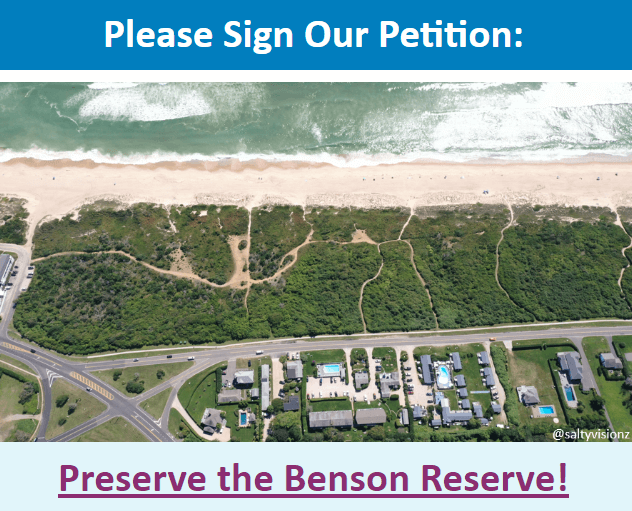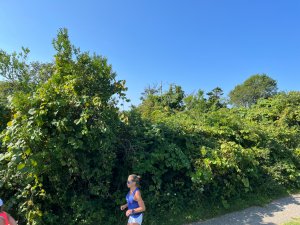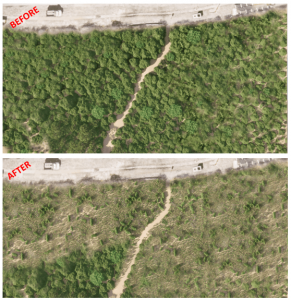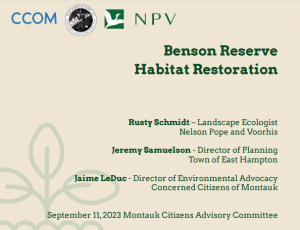Benson Reserve Habitat Restoration
Please join the many others who have voiced their support of the Benson Reserve Restoration Project by signing our petition. This is an important initiative that will positively impact Montauk’s environment and community.
In the 1990s, CCOM successfully fought alongside others for public acquisition and preservation of the Benson Reserve. Because of this the public has access to hiking trails and beach access on that property. However much of the land has been overtaken by invasive plant species, especially in a 16-acre area of the site immediately adjacent to the Old Montauk Highway. Invasive species can destroy biodiversity and cause habitat degradation, resulting in fundamental disruptions of ecosystems. A successful invasive plant management program will not only restore native plant, animal and insect species but also enhance resiliency through stabilizing the bluffs and improving water quality and restore the historic view shed on the Old Montauk scenic highway.
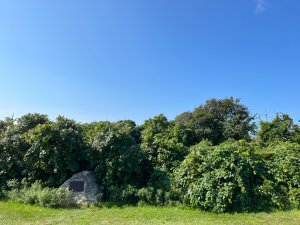
In partnership with the Town of East Hampton and Rusty Schmidt, a renowned landscape ecologist with Nelson, Pope & Voorhis, CCOM has begun developing plans for a comprehensive 10-year habitat restoration project at the 40-acre, town-owned Benson Reserve in Montauk. A recent presentation of those plans along with a comprehensive set of FAQ’s is available here (latest deck) The proposal was recently endorsed with overwhelming support by the Montauk Citizens Advisory Committee (CAC) at their monthly meeting on 9-11-23.
In the first 1–2 year phase of a 10-year management plan for the property, invasive plant species will be removed both mechanically and by the temporary and seasonal use of a small number of goats in an 8 acre area of the 40 acre site. Strict erosion control protocols will be in place and reseeding and replanting of any disturbed soils will also occur during this time. Additional replanting with native species and with native plant seeds collected on site will occur in the second year (phase 2). Depending on their success in the first year a decision will then be made on whether the goats would be required for a second season. In the subsequent 8 years the project will focus on maintaining the native habitat and preventing further spread of any remaining invasive species and long-term monitoring of the native plants, to ensure their continued health and establishment.
EAST HAMPTON TOWN Benson management plan
CLICK HERE to view the EH Town final draft Benson invasive species adaption management plan.
CLICK HERE to view the EH Town Benson Reserve Appendix Maps for Invasive Species Management Plan
Full presentation
To view the full presentation (along with a comprehensive set of FAQ’s) that was shared with the Montauk Citizens Advisory Committee on September 11, 2023, please click HERE (or on the image below).
FAQ
Download a PDF of the full list of frequently asked questions. Listed below are the top FAQs:
GENERAL QUESTIONS
Q: Can the entrenched invasive ecosystem be fully converted back to native?
A: We acknowledge that reversing the effects of invasive species is a complex challenge. Our goal is not to turn back time but to establish a native-dominant ecosystem.
Q: Does removing invasive species disturb the soil and does it invite more unwanted plants before native plants can be seeded?
A: We’re minimizing soil disturbance, using specific methods for flat areas and goats on steep slopes. Erosion protection measures are implemented before any work begins. The native plants we’re introducing are well-suited to this micro-ecosystem. It’s important to note that only the top third of the property, which amounts to 16 out of 40 acres and parallels the road, is being disturbed. This approach avoids disruption near the coast or mid-slope areas. The invasives are removed, and we promptly seed any disturbed soils. To ensure the seeds establish successfully and protect against rain events and erosion, we employ erosion control blankets or mulch. This seeding process happens immediately, and the soil remains protected as the native plants get established, minimizing the potential for invasives to reseed.
Q: How will invasive plant species be managed during the restoration project?
A: Invasive plant species will be removed both mechanically and, in the first year, by using a small number of goats. Goats have been proven effective in managing invasive vegetation like the vines we are looking to be managed. After the initial removal, continued monitoring and maintenance will be required monthly to observe any new young invasive species germinating to be removed by hand and to plant any locations that no plants are germinating.
Q: Knowing how difficult it is to eradicate Japanese knotweed, is it even worth trying to at the Benson Reserve?
A: Absolutely. Japanese Knotweed can be difficult to eradicate, but it is possible. Right now, it is only present on 0.1% of the Benson Reserve, which makes this an opportune time to remove it before it spreads further. With repeated cutting (5+ times/year), Japanese knotweed can be controlled and eventually eliminated.
GOATS
Q: Why is using goats considered a good method for removing invasive plant species on a dune?
A: Using goats is a beneficial method for invasive plant removal on dunes because they are highly effective at eating a wide range of invasive plants but not grasses, reducing the need for herbicides and mechanical removal methods reducing soil disturbance, and reducing the tangled web of vines for easier access. They will provide sunlight for the native grass species to germinate in the dune while continually eating the vines that are trying to reestablish.
Q: Are there economic benefits to using goats for invasive plant removal on dunes?
A: Yes, using goats can be cost-effective as they require less labor and equipment compared to mechanical removal methods, and they can access steep or challenging terrain. The areas that the goats will be targeting are on the steep portions of the project where mechanical methods are not safe and human hand removal is too time-intensive and costly.
Q: Will the goats require special fencing in Benson?
A: Yes, goats need appropriate fencing to keep them within the targeted area. The fencing will not be a permanent structure and will be removed from the site when the goats are removed. The fencing is an open woven wire fence, that is not obtrusive to the visitors.
Q: How many goats will be at the project site?
A: A total of 14-21 goats in 4 separate locations comprising 8 acres within the 40-acre Benson Reserve. The number of goats in each area is based on a grazing density of 2-3 goats/acre and therefore will depend on the acreage of each area as follows:
1.33 acres: 2-3 goats
3.18 acres: 6-9 goats
1.06 acres: 2-3 goats
2.05 acres: 4-6 goats
Q: Will public access be restricted by this project?
A: No. The current trails that exist on the property will remain open.
Q: Do goats used for invasive species control bite humans or other animals?
A: The goats proposed for this invasive species control are not aggressive toward humans or other animals, they have been specifically selected for these types of projects. They are retired goats from milking and breeding programs, only wanting to spend the remaining years grazing. They are browsers, primarily interested in eating vegetation. However, the goats will be kept in enclosures away from humans and other animals.
Q: Will the goats be used year-round for invasive plant management on Benson?
A: Goats will only be used seasonally, typically during the growing season when invasive plants are most abundant.
Q: Are the goats going to be there every year?
A: No. The goats will be brought to the Benson Reserve to graze invasive plants within 4 designated, enclosed areas for 7 months. Depending on their effectiveness in these 4 areas, a determination will be made at the end of this phase whether they may be required for a second season. The ongoing management of invasive species in subsequent years will be a combination of hand and mechanical removal and will not involve goats.
Q: Do goats have a strong odor when used for invasive plant management?
A: Goats have a distinct natural odor, but it is usually not overpowering. Their odor is generally less offensive than other livestock animals, and because we will have only a small number of goats at each location, the smell will likely be unnoticeable.
Q: Are goats noisy when employed for invasive plant removal?
A: Goats are relatively quiet animals. They may occasionally make sounds like bleating or low-toned vocalizations when disturbed or herded, but they are not known for being particularly noisy compared to other livestock, in fact a number of goat herds being used in urban areas are so quiet that collar bells are used to help with locating them.
Q: Are there other areas where goats are being used for dune restoration and invasive plant control?
A: The use of goats for weed and invasive plant management has been studied and implemented throughout the Northeast, and locally at Heckscher Park, Prospect Park and Staten Island and in coastal locations.
Interactions Between Invasive Species and Butterflies, Migratory Birds, and Coastal Songbirds
Q: What is the connection between invasive plant removal and the survival of migratory birds?
A: Removing invasive plants enhances the availability of native vegetation, which provides better nesting sites and food sources for migratory birds during their stopovers and breeding seasons in Montauk. Our insects (90%) require a host plant or specific species of plants to develop in their growth, for instance the Monarch requires milkweed. 90% of our terrestrial birds eat 6,000 insects to raise a brood of birds, without the insects, the birds are not able to be reared. The Cornell Ornithological Lab has calculated a decline of 35% of the bird population across the US since 1970, primarily due to habitat loss, including the decline of insects to feed those broods.
Q: What role do coastal songbirds play in Montauk’s ecosystems?
A: Coastal songbirds contribute to ecosystem health by aiding in pollination and seed dispersal, making them vital for maintaining the diversity and resilience of Montauk’s coastal habitats.
Q: How do invasive species disrupt coastal songbirds in Montauk?
A: Invasive species can alter the structure of coastal habitats, making it harder for songbirds to find suitable nesting locations and food resources, ultimately affecting their populations. Our invasive species of Long Island are not host plants, they come from other parts of the world and have not evolved with the ecosystem of our coastal zone, providing very little to no benefit to our habitat, songbirds, and resources.
Q: How do invasive plants harm monarch butterflies in Montauk?
A: Invasive plants can crowd out native milkweed and our seaside goldenrod. The milkweed, which is essential for monarch butterflies to lay their eggs and provide food for their caterpillars, while seaside goldenrod is essential nectar source for the butterflies to migrate. This can lead to a decline in monarch populations, in fact this past year, Monarchs have been listed due to the vast population decline.
Q: Does removing invasive species disturb the soil and does it invite more unwanted plants before native plants can be seeded?
A: We’re minimizing soil disturbance, using specific methods for flat areas and goats on steep slopes. Erosion protection measures are implemented before any work begins. The native plants we’re introducing are well-suited to this micro-ecosystem. It’s important to note that only the top third of the property, which amounts to 16 out of 40 acres and parallels the road, is being disturbed. This approach avoids disruption near the coast or mid-slope areas. The invasives are removed, and we promptly seed any disturbed soils. To ensure the seeds establish successfully and protect against rain events and erosion, we employ erosion control blankets or mulch. This seeding process happens immediately, and the soil remains protected as the native plants get established, minimizing the potential for invasives to reseed.
Partner and Plan
Q: What environmental review is being done for this project?
A: While this habitat restoration project does not require environmental review under SEQRA, the Town has reviewed the project for potential short and long-term impacts, and worked with project partners to ensure any potential impacts such as erosion, stormwater runoff or potential impacts to public access are avoided completely or mitigated to the maximum extent possible.
Q: What outreach to adjacent property owners and public awareness is being planned?
A: Before any work commences all adjacent property, owners will be notified and provided with details of the project by EHT. Also, both CCOM and EHT will maintain a website portal with all relevant information and CCOM will be providing regular public updates on progress throughout the 10 year plan period.

